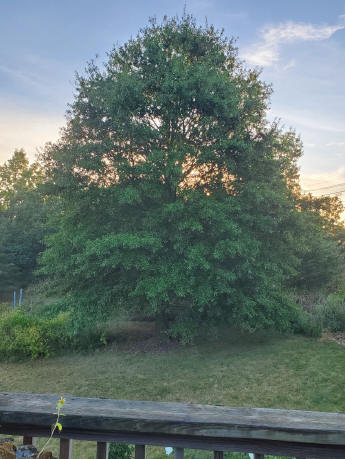Martie Young
Adams County Master Gardener
 When I moved into the house I have lived in for almost 60 years, there were no trees on the property and only four basic shrubs where mosquitos lived! To me, this was unacceptable, and I started to think about planting a tree in the backyard. I settled on a ginkgo and watched it grow. It is a nice straight tree with no problems, and it gets a wonderful yellow fall color with the added benefit of most of the leaves falling on the same day (saves a lot of raking). Then a baby pin oak started to come up in a flower bed--I would cut it off but couldn't quite get rid of it, so I left it grow. Now I have two large trees approximately 40 plus feet tall.
When I moved into the house I have lived in for almost 60 years, there were no trees on the property and only four basic shrubs where mosquitos lived! To me, this was unacceptable, and I started to think about planting a tree in the backyard. I settled on a ginkgo and watched it grow. It is a nice straight tree with no problems, and it gets a wonderful yellow fall color with the added benefit of most of the leaves falling on the same day (saves a lot of raking). Then a baby pin oak started to come up in a flower bed--I would cut it off but couldn't quite get rid of it, so I left it grow. Now I have two large trees approximately 40 plus feet tall.
In the meantime, I joined the Master Gardener program and learned more about trees. I also belong to the Hanover Area Historical Society and help with gardening on their property. The centerpiece of that garden is a Bur Oak, which is possibly 100 years old and very large. The Historical Society takes good care of all the plants in that yard since most of the trees have been there 100 + years. However, in the 20 years of the Historical Society’s care, that oak tree has never gotten acorns. Recently I learned why. It is the only Bur oak in the surrounding neighborhood. It doesn't have another Bur Oak to help with pollination. Most oak trees are wind pollinated and must be pollinated by the same kind of oak.
I bought Doug Tallamy's current book, The Nature of Oaks, and found out all the things I have been doing wrong! The book by Tallamy is obviously about oak trees, but equally about the insects that help the trees thrive. Nothing lives in a vacuum and without insects to partner with trees (and all living things) we wouldn't be here either.
Native plants are usually described as plants that have been in America for hundreds of years and the insects that pollinate them have also been here the same amount of time. The plants and the insects have adjusted and compromised until they have accepted (and need) each other. On the other hand, if you buy a plant or tree that is native to a different country you may have problems. Look at spotted lantern fly, emerald ash borer, plum pox and hemlock woolly adelgid. All invasive species here, with no natural predator, no control or no symbiotic relationship with our native trees that they are affecting.
Many people buy bird food made up of seeds and think that the baby birds will eat seeds. Baby birds are fed caterpillars by their parents, almost exclusively. Research has shown that even in winter birds are eating caterpillars. Some of these are inchworms--very thin worms that are hidden on tree limbs and are almost invisible. But the birds do find them and eat them even in January.
Scientists count caterpillars to determine the number of species of insects that native plants host. There are over 500 caterpillar species for oaks (Quercus) and no caterpillars at all for yellowwoods (Cladrastis). This fact shows why you should have at least one oak in your yard. Oaks, cherries, willows, birches, hickories, pines, and maples are aiding the vast numbers and types of insects that support animal populations. These trees are considered "keystone" plants due to the quantity of insects and animals that feed on and live in those trees. If you have at least one of these plants in your yard, there will be enough insect food for a few birds to reproduce. It isn't enough just to have native plants—these native trees should be included in any landscape.
If you are visiting Hanover and the Warehime-Myers Mansion or the Arboretum, you will find three enormous oak trees: the Bur Oak, Turkey Oak, and Swamp White Oak. All are impressively large and all native to the US. There are smaller oaks such as the Post Oak, and an upright oak for narrow spaces. Recommended for small trees and small yards are Bear Oak, Bluejack Oak, Sand Post Oak and Dwarf Chinkapin Oak. Don't use the excuse of raking the leaves--mulch them and let them on your lawn to disintegrate slowly. And don't plant grass all the way to the trunk of your oak--you may damage the bark with the mower. Also, mulch should only be a couple inches thick. And if mulch is not your choice, maybe plant a little garden under your oak consisting of ferns, spring ephemerals, and ground covers such as wild ginger, violets, or small shrubs. And keep the leaf litter! This provides needed habitat for overwintering insects.
I would recommend reading Doug Tallamy’s book "The Nature of Oaks" to learn more about the mighty oaks and the critters that are supported by them. He’s not only an entomologist and specialist in this area, but he also lives in southeastern Pennsylvania, so he has the same gardening problems as the rest of us!
Read other articles about tree care